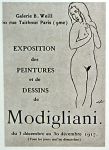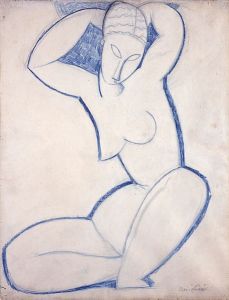Jenkins and Roddy Cutts return with Widmerpool to his flat. Pamela Fitton is not up and about yet.
Widmerpool glanced around the room and made a gesture of simulated exasperation.
‘She’s been altering the pictures again. Pam loves doing that — especially shifting around that drawing that her uncle Charles Stringham left her. I can never remember the artist’s name. An Italian.’
‘Modigliani.’ [BDFR 188/176]
We will learn about the travels of this drawing as it accompanies Pamela in her escapades, but in BDFR Jenkins describes it in no more detail [ BDFR 192/180, 204/191, 241/227]. We know the provenance of this drawing back only to the summer of 1933, when Jenkins saw it in Stringham’s flat. Provenance here is not trivial since Modigliani counterfeits are common. The drawing seems incongruous with Stringham’s collection of family memorablia and aristocratic sporting prints.
Modigliani (1884-1920) initially studied in Rome, Florence, and Venice, then moved to Paris in 1906. He reportedly could produce a hundred sketches a day but destroyed or lost many of them. No one knows what became of many that he gave to girl friends.
From 1910 t0 1912 his great love was Anna Akhmatova, a famous Russian ballerina. He drew her at least 16 times, but most of the drawings have been lost. Three, including Kneeling Blue Caryatid, were shown in 2015 at the Estorick Collection of Italian art in London.

Kneeling Blue Caryatid
Modigliani, c. 1911
Blue Crayon, 17 x 11 in
from http://www.modigliani_drawings.com

photo of poster for Modigliani’s only one-man exhibition, 1917
©Archives Berthe Weill, in public domain from Wikimedia.org
Modigliani had a remarkable visual memory. He and Akhamatova visited the Louvre together; then he returned to his studio to draw her, modeled on an Egyptian sculpture of a kneeling Isis. Modigliani gave this drawing to his friend Dr. Paul Alexandre and its subsequent provenance is well documented, so we know that it was never in Stringham’s possession.
Modigliani’s only one-man exhibition opened in Paris in December, 1917, but was shut down within in days by the police, who found his nudes obscene.
Modigliani was known for depicting elongated torsos and faces, as shown in the drawing below, which belonged to Sir Jacob Epstein.

Caryatid
Modigliani, 1913-14
pencil and blue crayon on paper, 22 x 16 in
Garman Ryan Collection, The New Art Gallery, Walsall
photo in public domain from Wikimedia.org
Like Toulouse Lautrec, who influenced him artistically, Modigliani abused hashish, alcohol and absinthe; he died penniless of tuberculous meningitis in 1920. His pregnant mistress, Jeanne Hebuterne, committed suicide a few days later.
Modigliani’s reputation when Stringham would have acquired the work was more for his flamboyant bohemian life style than for his art; however, early in his career his genius was appreciated by British artists of Powell’s set, like Sir Jacob Epstein and Nina Hamnett, whose relationship with Modigliani is the source of many anecdotes.(TKBR 137, 161-2). Maybe it is these sexy bits that attach Pamela Fitton to the drawing.